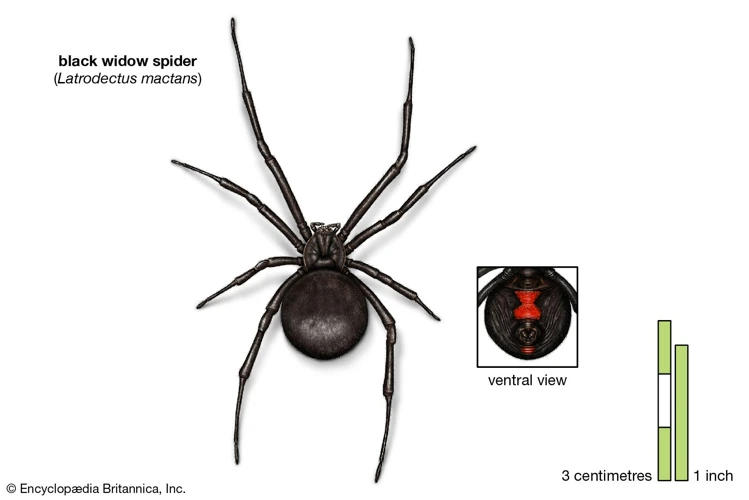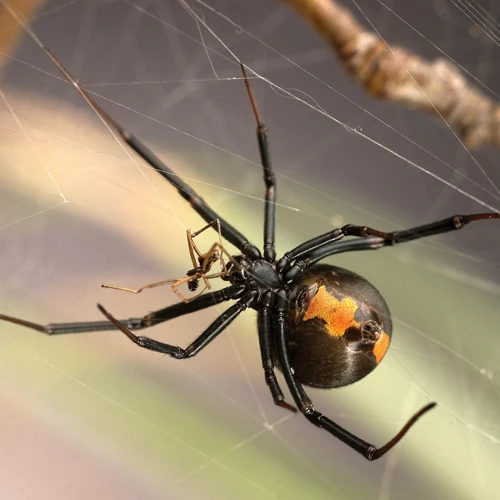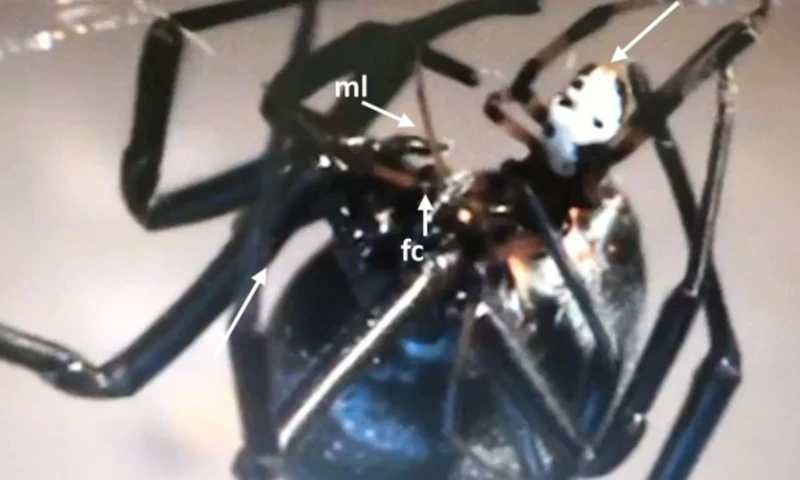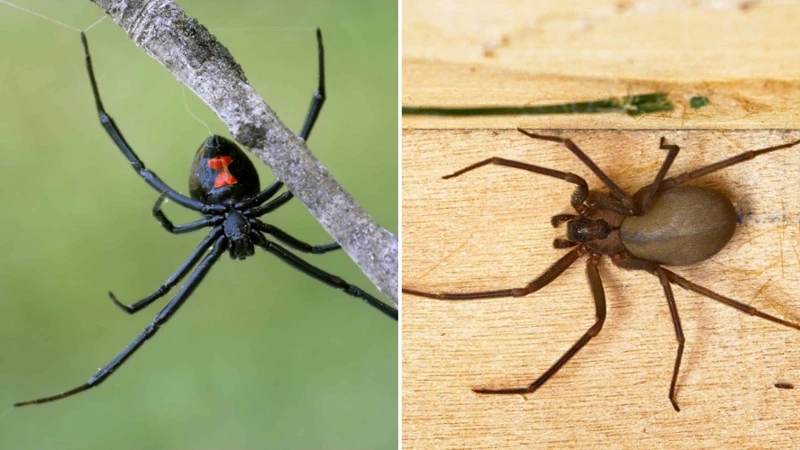Introduction

The mating behaviors of black widow spiders have fascinated researchers and laypeople alike for years. The innate cannibalism of these arachnids has led to some gruesome and deadly encounters, particularly for male spiders approaching females. However, the complexities of these mating rituals go beyond just the act of consumption. From initial approaches to courtship dances, and ultimately copulation and sacrifice, the behaviors of male and female black widow spiders offer insight into the evolution of reproductive strategies and the adaptability of these unique arthropods. Let’s explore the different mating behaviors of male and female black widow spiders in more detail.
About Black Widow Spiders
Black widow spiders are notorious for their venomous bite and their unique mating behaviors. These spiders belong to the Latrodectus genus of the Theridiidae family and are found in different parts of the world, including the United States, Australia, and Europe. Interestingly, black widow spiders are sexually dimorphic; males are smaller in size, often exhibiting more varied color patterns than females, which are typically black with the recognizable red hourglass marking on their abdomen. Here are some key characteristics of black widow spiders:
- Venomous Bite: Black widow spiders are well known for their venomous bite. They have a set of specialized fangs located in their front jaws, allowing them to deliver potent neurotoxins to their prey. These toxins can cause muscle rigidity, spasms, and even death in some cases.
- Mating Behaviors: Black widow spiders exhibit unique mating behaviors that are different in males and females. Male black widow spiders engage in mating competitions to find a suitable mate, whereas females are more selective in choosing a mate and often consume their mate after copulation.
- Mate Selection: Female black widow spiders use pheromones to attract males for mating. These pheromones are produced by specialized glands located on the female’s body. Males use these pheromones to locate a potential mate and initiate the courtship dance.
- Copulation and Sacrifice: Copulation between black widow spiders can be dangerous for the male. After copulation, the female may consume the male as a source of nutrition. As a result, male black widow spiders are cautious when approaching a potential mate.
- Mating Frequency: Black widow spiders mate only once a year, and the mating season typically lasts from late spring to early fall. However, males may attempt to mate with multiple females during this time.
- Mating in Captivity: Black widow spiders can be kept in captivity, but breeding them requires caution since they are known to cannibalize their mates. Preventing inbreeding is also an important consideration. Some experts recommend introducing a new male into the female’s enclosure every few breeding cycles to prevent inbreeding.
Understanding the behaviors and characteristics of black widow spiders is important for researchers and enthusiasts alike. By studying these spiders, we can gain insights into their biology, behavior, and ecology. Whether one is interested in their venomous bite or their unique mating behaviors, black widow spiders are fascinating creatures that continue to intrigue and mystify us.
Male Mating Behaviors

It is fascinating to observe the mating behaviors of male black widow spiders. In the world of arachnids, male spiders have evolved intricate courtship rituals and tactics to attract a mate and ensure their genes are passed on to the next generation. Here, we explore the various remarkable male mating behaviors of black widows, from their initial approach to their ultimate sacrifice.
Initial Approach
When it comes to the initial approach, male black widow spiders have an interesting way of attracting a female’s attention. They often approach the female while she’s feeding and use their legs to tap a specific rhythm on the web. This tapping creates vibrations that the female can detect. If the female is receptive, she will respond by tapping back.
This tapping ritual is essential for determining whether the female is interested or not. If she doesn’t respond, the male may try several more times before giving up and finding another mate. However, if she does respond, the male will approach the female slowly and cautiously.
During this approach, the male uses his front legs to touch the female in specific areas. He then uses his pedipalp, a small appendage located near his mouth, to transfer pheromones to the female. These pheromones play a significant role in the courtship ritual that follows.
Male black widow spiders engage in intense mating competition and have developed specific strategies over time to maximize their chances of successful mating. The initial approach is just the beginning of a complicated process that can often end in the male’s death.
Inbreeding prevention is essential for maintaining a health black widow population. In the wild, black widows are subject to a wide range of threats, including habitat loss and disease. By studying black widow mating behaviors, scientists can gain a better understanding of how to protect these spiders and other species like them.
If you’re interested in learning more about mating rituals and behaviors of black widow spiders, you can read our article on mating rituals of black widow spiders.
Courtship Dance
During the courtship dance, the male black widow spider tries to capture the attention of the female. This is a critical stage in the mating process because the female is known to be aggressive, and there is a high possibility that she may attack and kill the male. The dance is a delicate process that involves a series of complex movements and visual displays that can last for several hours.
In the first stage of the courtship dance, the male approaches slowly and cautiously towards the female. He swings his body in a zigzag pattern to draw the female’s attention, using his strongly muscled legs to move expertly over the web. This initial approach is a crucial step in the mating process because if the female is not receptive to the male’s advances, she may attack and kill him.
During the second stage, the male begins to vibrate his web, sending vibrations to the female spider. This is done using his front legs, which he moves rapidly up and down. The vibrations produced by the male spider are known to mimic those generated by prey insects that happen to land in the female’s web. If the female spider is receptive to the male’s advances, she will often respond positively to these vibrations.
As the dance continues, the male spider escalates his movements, making more abrupt and erratic twists and turns. The male also performs a ritualized display with his pedipalps, which he extends towards the female, touching her delicately with them. These movements carry chemical signals that act as pheromones to encourage the female’s acceptance of the male.
Finally, if the female is receptive, the male will mate with her. Interestingly, the copulation process is quick, lasting only a few seconds. Once he has finished mating, the male will often quickly disengage from the female, knowing that his life is in danger. As mentioned previously, the female black widow spider is known to be aggressive and will frequently kill and eat the male after mating.
The courtship dance of the black widow spider is a complex process that involves a series of intricate movements and visual displays by the male. This dance is a crucial stage in the mating process and can last for several hours. If successful, the dance will eventually lead to copulation, with the female spider often killing and eating the male spider after mating. To learn more about black widow spider mating behaviors, visit pheromones in black widow mating.
Copulation and Sacrifice
When it comes to black widow spider mating, there is an unmistakable and gruesome pattern that seems to always play out. Copulation and sacrifice are essential parts of the black widow spider mating process.
During copulation, the male black widow spider will insert his pedipalps (i.e. sex organs) into the female’s genital opening. This process can take anywhere from a few minutes to a few hours, depending on the species and the level of sexual competition between males.
Unfortunately for the males, copulation also signals the beginning of the end for them. After mating, the male often becomes an easy target for the female to kill and eat. In fact, it is estimated that up to 80% of male black widows are killed by the female after copulation.
This sacrifice is a result of both evolutionary strategy and nutritional necessity. For the female, having a meal ready after copulation ensures she is able to produce as many viable offspring as possible. And from an evolutionary standpoint, the males are disposable, serving their purpose of just reproducing with the female.
It is interesting to note that in some cases, males will try to avoid this fate by using various mating strategies. For example, some males will mate with a female while she is feeding, hoping to stay out of her sight and escape unharmed.
Copulation and sacrifice are integral parts of black widow spider mating. While it may seem gruesome to us, it represents an important evolutionary tactic for this species to ensure reproductive success. If you want to know more about prevention inbreeding with black widow spiders, click this link.
Female Mating Behaviors

As with their male counterparts, the mating behaviors of female black widow spiders are equally fascinating and complex. Understanding the mechanisms behind female mate selection and copulation is essential for comprehending the overall reproductive process of these dangerous arachnids. In this section, we will explore the unique strategies employed by female black widow spiders during the mating process, including mate selection and the ultimate act of copulation and sacrifice. Through this discussion, we gain insight into these intriguing creatures and their reproductive habits.
Mate Selection
Mate Selection: Mate selection is a critical stage in the mating behavior of black widow spiders. Female black widows exhibit a strong preference for larger and healthier males. Research has shown that larger males are more successful in mating and are preferred by females due to their perceived genetic fitness (source). Females also tend to choose males with a bigger body size as they are more likely to provide a good genetic contribution to the offspring (source).
Another crucial factor in mate selection is the availability of mates. In situations where female black widows are scarce, males compete more aggressively for mating opportunities. This competition can even lead to male cannibalism, where larger males may kill and eat smaller rivals before mating (source). This feeding behavior is known as “intrasexual competition”, where males compete with each other to maximize their reproductive potential (source). In intrasexual competition, the biggest and strongest males usually win the chance to mate.
To select their mates, female black widows use chemical cues or pheromones secreted by males. Male black widows produce pheromones that females can detect from a distance to identify potential mates. Male spiders frequently gift-wrap their sperm by enveloping them in a protein package called a “spermatophore”. The spermatophore not only contains the sperm but also provides the female with a protein-rich source of nutrition, which helps replenish her energy reserves after copulation.
However, once the male spider courts the female spider and successfully mates, he usually becomes a sacrifice. In fact, male spiders almost always die after mating with a female black widow spider. This is one of the most intriguing aspects of black widow spider mating behaviors. It also explains why there is a higher frequency of black widow mating in captivity then in the wild, as there are fewer chances for male spiders to escape from the female’s cannibalistic tendencies (source).
Mating in captivity for black widows is different from their natural mating. In controlled settings, researchers can observe and better understand the mate selection process for black widow spiders. In the wild, however, black widow spider mating behaviors are less predictable and can be challenging to observe.
Copulation and Sacrifice
Male and female Black Widow spiders have distinct mating behaviors, and both involve mating and then sacrificing the partner. The process of copulation and sacrifice is a significant factor that sets Black Widow spiders apart from other species.
During mating, the male climbs onto the female’s back and inserts his pedipalps into the female’s genital opening, fertilizing the eggs that may eventually become offspring. Male Black Widows have unique mating strategies, including advanced courtship dances, fighting off competitors, and achieving copulation frequency.
On the other hand, females have the ultimate decision-making power when it comes to mate choice. They choose the males that exhibit specific behaviors, colors, or pheromones. After the successful mating, the females consume the male’s body, which provides them with valuable resources, including nutrients and proteins.
Here is a table to illustrate the differences in the mating behaviors between male and female Black Widows:
| Male Black Widows | Female Black Widows | |
|---|---|---|
| Mating Behavior | Mate with multiple females, fight off competitors, and secure copulation frequency | Select the best mate, mate only once in a lifetime, and consume the partner after mating |
| Mate Selection Factors | Physical traits, behaviors, and pheromones | Physical traits, behaviors, and pheromones |
| Copulation | Inserts pedipalps into female’s genital opening to fertilize eggs | Receptive to male’s pedipalps, which fertilizes her eggs |
| Sacrifice | May become a meal for the female after copulation | Consumes male’s body after successful mating |
Studying the mating behaviors of Black Widow spiders can provide insights into various evolutionary mechanisms, including sexual selection and reproductive strategies. By understanding these behaviors, we can learn more about how these spiders evolved and adapted to their environment. In the next section, we will discuss the importance of studying Black Widow Spider Mating Behaviors.
Similarities and Differences

As we have explored the different mating behaviors of male and female black widow spiders, it is important to note the similarities and differences between the two. Both male and female black widow spiders engage in copulation and sacrifice, but their approaches and strategies differ. Understanding these differences can shed light on the frequency of black widow mating and the male-male competition that occurs during mating season. Additionally, studying the female’s approach to choosing a mate and the male’s courtship dance can reveal more insight into black widow spider mating strategies. However, it is also important to acknowledge the dark side of these behaviors, which includes the female’s tendency to eat their mates and the male’s risk of being killed during copulation.
Copulation and Sacrifice
During copulation, male black widow spiders use their specialized pedipalps, or sex organs, to inseminate the female. This process can take anywhere from several minutes to several hours, during which the male must be careful not to trigger the female’s predatory instincts. Indeed, it is not uncommon for males to be killed and eaten by the female after copulation, a behavior known as sexual cannibalism.
Female black widow spiders eat their mates, which is a common feature of many spider species. While this behavior may seem counterintuitive, it has actually been shown to have significant reproductive benefits for females. By consuming their mate, females gain valuable nutrients that they can use to produce more eggs and increase the likelihood that their offspring will survive to maturity.
Interestingly, not all male black widows are equal in the eyes of females. Some males are more desirable than others due to their size, strength, or other traits. This can lead to intense competition among males for the chance to mate with a female, which may involve elaborate courtship displays and physical combat.
The mating behaviors of male and female black widow spiders are complex and fascinating. By studying these behaviors, scientists can gain valuable insights into the biology and evolution of this important group of spiders. For more information on the frequency of black widow mating, check out this link. To learn about male black widow mating competition, click this link. If you’re curious about the phenomenon of black widow spider killing their partners, you can read about it here: link. To discover more about the mating strategies of black widow spiders, visit this link.
Why Study Black Widow Spider Mating Behaviors?
As creepy as it may seem, studying the mating behaviors of black widow spiders is essential for better understanding the evolution and adaptation of species. Their unique mating behaviors, particularly involving the female black widow’s predatory tendencies towards her mate, have long been a subject of scientific inquiry.
Through studying these behaviors, scientists can gain insight into the developmental and behavioral patterns of these elusive creatures. The male’s courting behavior and the female’s selection of a suitable mate based on her instincts provide an opportunity for research into the complex social and communicative behaviors of black widow spiders.
Understanding the female black widow spider’s cannibalistic tendencies towards her mate is a fascinating topic of study in its own right. It may help us better understand how and why mate selection occurs in the animal kingdom. Additionally, it may offer insights into gender dynamics and how they may differ between different species.
Through studying the intricacies of black widow spider mating behaviors, scientists can gain valuable insights into the nature of biological evolution and adaptation. This knowledge is also critical for biodiversity conservation and for understanding the complexities of nature’s behavior. It also helps to explain why the popular belief that female black widow spiders always eat their mate is not entirely true.
Conclusion
In conclusion, the mating behaviors of male and female black widow spiders are fascinating and complex. From the initial approach to copulation and sacrifice, these spiders showcase unique and intricate behaviors that have been shaped by evolution. Despite the commonly held belief that female black widows always consume their mates, this behavior is actually quite rare and only occurs under certain circumstances.
This article explored the different mating behaviors of male and female black widow spiders, highlighting the various steps involved in courtship and copulation. While there are some similarities between the two genders, such as the eventual sacrifice of the male, there are also notable differences in approach and mate selection.
Studying these behaviors is important not just for our understanding of this particular species, but also for gaining insight into the broader field of animal behavior. By understanding how and why different animals engage in certain behaviors, we can better appreciate the diversity of life on our planet and the intricacies of the natural world.
As we continue to study black widow spiders and other species, we may also discover new insights into how evolution shapes behavior and how different species have adapted to their environments. While the mating behaviors of black widow spiders may seem strange or even gruesome to some, they are an important part of the natural world and worthy of continued study and exploration.
If you want to learn more about the eating habits of female black widow spiders, check out our related article on how and why female black widow spiders consume their mates.
Frequently Asked Questions
1. What is the scientific name for Black Widow spiders?
The scientific name for Black Widow spiders is Latrodectus.
2. How do male Black Widow spiders approach females for mating?
Male Black Widow spiders approach females by tapping their webs to alert them to their presence.
3. What is the courtship dance performed by male Black Widow spiders?
Male Black Widow spiders perform a complex courtship dance, which involves tapping their legs and vibrating their webs to signal their interest to the female.
4. Why do male Black Widow spiders sacrifice themselves during copulation?
Male Black Widow spiders sacrifice themselves during copulation to ensure their genes are passed on to the next generation, as females are known to eat their mates after copulation.
5. How do female Black Widow spiders select their mates?
Female Black Widow spiders select their mates based on chemical cues and the quality of the male’s web.
6. What can happen if a male Black Widow spider fails to properly perform the courtship dance?
If a male Black Widow spider fails to properly perform the courtship dance, the female may become aggressive and attack or kill the potential mate.
7. Do all species of Black Widow spiders exhibit the same mating behaviors?
While all species of Black Widow spiders share some mating behaviors, there are some variations in the specific courtship and copulation behaviors exhibited by different species.
8. What risks do female Black Widow spiders face during copulation?
Female Black Widow spiders face the risk of being injured or killed by their mates, and also face the possibility of being consumed after copulation.
9. How long does copulation typically last in Black Widow spiders?
Copulation in Black Widow spiders typically lasts for several hours.
10. What is the importance of studying Black Widow spider mating behaviors?
Studying Black Widow spider mating behaviors can provide insight into evolution, sexual selection, and the various mechanisms used by different species to ensure reproduction and offspring survival.






